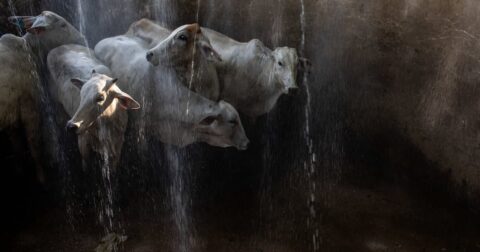Southwest Wisconsin Dairy Operation Linked to Spill Affecting Eight Miles of Trout Waters
Climate•4 min read
Analysis
A new investigation finds that deforestation of the Amazon for soy farming has continued despite a moratorium. Big meat and dairy companies are largely to blame.


Words by Jennifer Mishler
A new investigation finds that deforestation of Brazil’s Amazon to make space for soy farming has continued despite an international moratorium. The research by the Instituto Centro de Vida, and released jointly with Greenpeace’s Unearth, the Bureau of Investigative Journalism, and Ecostorm, reveals that 400 square miles of Amazon rainforest were lost in just ten years–and that soy produced on the farms in “areas most at risk from this deforestation” is “regularly shipped” to the UK and Europe to feed farmed animals.
An unsustainable demand for animal products, and the rise of industrial agriculture, fuels deforestation in the Amazon and around the world. According to Greenpeace, 80 percent of deforestation globally is the result of agricultural production, with a “significant driver” of this removal of forests being animal farming and the growing of feed for farmed animals. Among the most destructive industries is beef production, with cattle ranching accounting for 41 percent of tropical deforestation–and the majority, 72 percent, of deforestation in Brazil.
The moratorium prohibits the sale of soy produced on land deforested later than 2008. Since it first took effect in 2006, the moratorium did prevent the destruction of the Amazon for the direct purpose of soy production, reports The Guardian, and was followed by an 84 percent drop in the clearing of Amazon trees between 2004 and 2012. However, according to the recent report, the majority of the soy farm deforestation from 2009-2019 took place illegally, as land was cleared to grow crops other than soy or create grazing land for cattle.
But Mongabay writes that the “apparent success” of the moratorium is due in large part to the widespread destruction of Amazon land that occurred prior to 2006, leaving “plenty of room for soy expansion without cutting forest.” And as the new research uncovers, farms have been able to exploit a loophole, felling trees while still able to distance their products from the issue of deforestation.
The overseas markets for these soy products share in the blame.
“Legislation in the EU, UK and the US raises the stakes of this ongoing deforestation on soy properties,” says Holly Gibbs, a geography and environmental studies professor at the University of Wisconsin-Madison. “The soy industry could consider broadening the Amazon soy moratorium to close the door to all deforestation connected to soy.”
The Amazon is a vitally important ecosystem, playing a key role in absorbing atmospheric carbon, and therefore helping us to fight the ongoing climate crisis. It is also home to many Indigenous communities displaced by the destruction of land they have long protected. Greenpeace’s Unearth points to an example in Marãiwatsédé, the Indigenous reserve where 75 percent of the native vegetation is gone.
Rampant deforestation of the Amazon rainforest crucial to humans and wildlife alike continues, as trees are felled and fires are intentionally set to make way for new soy farms. In fact, Amazon deforestation reached a 15-year high in November 2021.
An insatiable global demand for meat, especially in Western nations such as the United States and in China, where meat consumption is soaring, is fueling the deforestation of the Amazon and other forestlands cleared for soy production. The majority of the world’s soy, 77 percent, goes to feed livestock raised for meat and dairy.
“Brazil’s ability to conjure up land cheaply and efficiently to meet the ever-increasing demand for meat products has come at a cost to the planet’s health,” Sentient Media’s Devatha P. Nair writes, tying factory farming in the U.S. to the human-set fires that ravage the Amazon. “Ignoring the obvious links between the factors that drive deforestation and our current food choices is not sustainable.”
This rate of destruction cannot continue without dire repercussions. A study published in July 2021 concluded that the Amazon rainforest is now emitting more carbon than it is able to capture. This turning of the Amazon from a carbon sink to a carbon source is a massive blow to our ability to fight the global climate crisis we’re facing, as fires set to serve farming interests continue to threaten the loss of one of our precious few environmental safety nets.